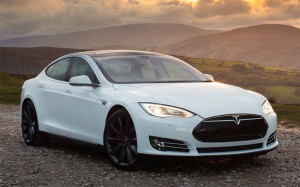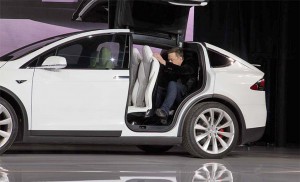Tesla Motors topped the 50,000 sales mark for 2015, its best-ever effort and slightly more than the maker had signaled it would deliver for the year – but that was based on revised numbers released last autumn and still fell short of the EV maker’s original target.
During the final quarter, Tesla delivered 17,400 of its battery cars, including a handful of the new Model X SUVs. That was 75% more than the same quarter in 2014, and a 48% increase over Tesla’s previous quarterly record.
Tesla has far more ambitious goals for 2016, and, in a Sunday release, the company said the early roll-out of the new Model X is “in line” with its plans. All told, 208 of the battery utes have been delivered since sales began in September.
The Palo Alto automaker released its final 2015 sales numbers two days ahead of the rest of the auto industry – and just before the opening of the annual Consumer Electronics Show in Las Vegas. The 2016 CES is expected to bring significant news about electric vehicles.
Among other things, new Chinese-owned competitor Faraday Future is set to reveal its own battery prototype on Monday. Volkswagen will show off a new battery-powered minivan and General Motors will show the production version of the Chevrolet Bolt.
(Start-up Faraday Future picks site in Nevada to build mysterious battery car. Click Here for details.)
The latter model is expected to deliver about 200 miles range per charge at a price of around $35,000, or half of even the lowest-priced version of the Tesla Model S sedan. The California carmaker is working up its own entry model, but while it plans to begin taking orders for the $35,000 Model III this spring, production is still two years away, at the earliest.
Nonetheless, Tesla is betting it can dramatically ramp up sales in 2016 with the addition of the Model X, its third electric vehicle ever and the second currently in production. The new model, with its distinctive “falcon wing” doors carries a premium of about $5,000 over comparable Model S sedans. It will be offered in several different variations, prices ranging from $80,000 to $144,000 before factoring in a $7,500 federal tax credit.
Tesla says it is taking a cautious approach to the roll-out of the Model X to ensure quality. That is a sore spot for the maker which was slammed by influential Consumer Reports magazine in October. Though the magazine had only months earlier raved about the Model S sedan’s features and performance, it wound up pulling the battery-car’s Recommended Buy endorsement because of reliability issues.
“Reliability has moved from ‘Average’ to ‘Below Average,’” Jake Fisher, CR’s director of automotive testing said during an appearance before the Automotive Press Association. As a result, he added, “We’re no longer recommending the Model S.”
(For more on Tesla’s reliability problems, Click Here.)
Nonetheless, Tesla CEO Elon Musk claimed in September that the carmaker had already received 25,000 pre-orders for the Model X. He cautioned that some customers would have to wait as much as 12 months to take delivery.
During a conference call with reporters, Musk said the goal was to bring total production at the Tesla plant in Fremont, California to just under 2,000 vehicles a week in 2016. That would work out to something short of 100,000 vehicles if Tesla hits that target, or nearly twice the total for 2015.
That would be a much-welcomed development for investors who have continued to buoy Tesla’s stock despite its continuing financial losses.
Longer-term, Musk has said he expects to see Tesla sales climb to 400,000 or more when the more mainstream Model III is added to the line-up. The company is also working on a new version of its 2-seat Tesla Roadster, though that will remain a halo car, rather than a serious contributor to sales numbers.
(Ford and Google deal to go beyond autonomous cars. Click Here for the full story.)




…and they are losing money on every car they sell. You can fool some of the people some of the time but the house of cards is shaking pretty badly.